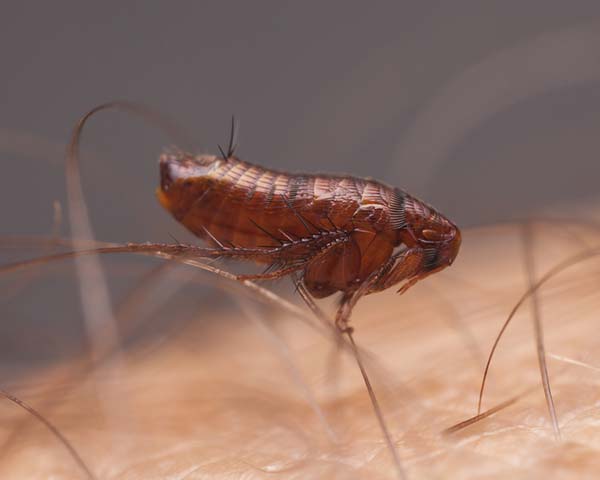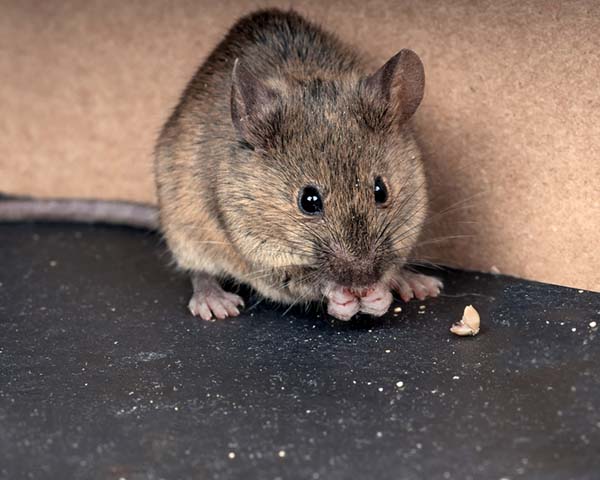
Pests
Find out more about common Northern Beaches Species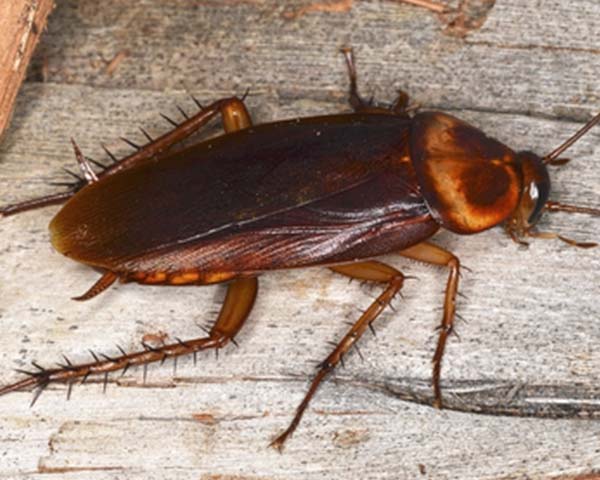
American Cockroach
Commonly found in pantries and wall cavities
The American Cockroach is typically 4cm in length and 0.7cm in height, although it is common to see examples as large as 5.3cm in length. Their body is generally a dark brown colour with light brown to yellow highlights around the edges of its body and limbs. American Cockroaches are most active at night where there is little light.
American Cockroaches are commonly found within and around Australian households seeking out dark, warm, and moist spaces where they can hide from predators (or humans) until they need to venture out to find food. Cockroaches are very opportunistic and often find their way into wall cavities, under floorboards, behind large items of furniture and into ceiling cavities. During the winter months and colder weather, American Cockroaches move indoors seeking warmth in large numbers.
Cockroaches generally feed on a large range of waste left behind by humans. Foods are very varied from human skin, to bread crumbs, to general food scraps. Keeping your home or business tidy is crucial to prevent the unwanted infestation of cockroaches.
Cockroaches cannot harm humans physically, but do harbor dangerous germs such as salmonella that can be potentially life threatening to humans. Cockroaches often crawl over food, food preparation surfaces, and other items such as toothbrushes, toiletries and more. This promotes the spread of germs and can cause illness with relative ease.
Large infestations of American Cockroaches often cause a bad odour that is secreted by the pests and can promote the spread of disease. Cockroaches commonly make their way into food container and packaging, spoiling the food and putting humans at risk of contracting disease.
Generally American Cockroaches lay 10 eggs at a time, however they are known to lay up to 90 eggs in some cases. This makes it extremely important to control American Cockroach Populations as soon as they are noticed so that their numbers do not grow rapidly. The lifespan of an American Cockroach is generally 90 to 700 days.
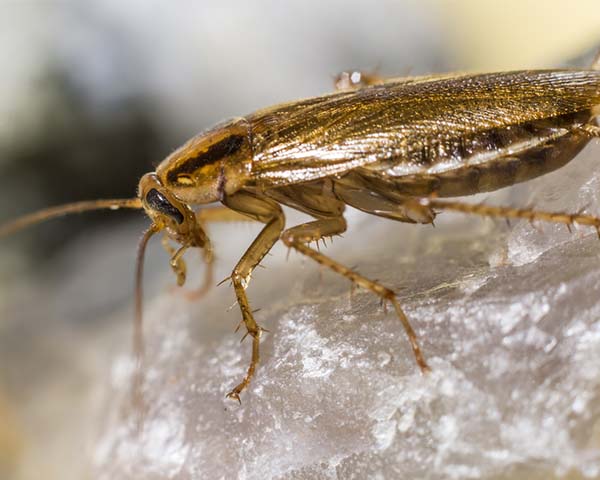
German Cockroach
German Cockroach
Commonly found in pantries and dark areas
The German Cockroach is one of the smallest cockroach species and is typically 1.1cm to 1.6cm long. They vary colour from tan to nearly black, they have two dark lines starting from its head to the wings, although they do have fully developed wings they can’t fly. German Cockroaches are mostly active at night, when they search for food, water, and mates. They are sometimes seen during the day if there is a heavy population of them.
German Cockroaches are generally found in kitchens and in bathrooms. During the day they hide in cracks and other dark areas that provide a warm, dark and humid environment (they can’t survive severe cold weather).Their flat bodies able them to move in and out of cracks and narrow places with ease.
Cockroaches are mostly scavengers and will feed on a wide variety of foods. They are especially like starches, sweets, fatty foods, meat products. When there is a shortage of foods they sometimes eat items found around the house such as soap, glue, and toothpaste. In harsh conditions they can turn cannibalistic, chewing at each other’s wings and legs.
German Cockroaches produce feces with a bad odour, when populations are high, these feces may result in a noticeable odor in the area of the infestation. These cockroaches carry allergens which many people have allergic reactions such as rashes, watery eyes, sneezing, and asthma. Bacteria, protozoans, and types of viruses have been found on cockroach bodies. Different types of food poisoning, diarrhea and other illnesses are the main diseases transmitted by German Cockroaches. Organisms causing these diseases are carried on the legs and skin of cockroaches and are left on food and utensils as they search for food which puts humans at risk.
German cockroaches go through three different life stages: egg, nymph and adult. These cockroaches breed continually. In their approximate 100 day life span, a female cockroach is capable of producing up to 400 eggs. This means it is extremely important to control German Cockroach populations as soon as they are noticed so that their numbers do not grow rapidly.
Fleas
Commonly found on pets, pet bedding, and clothing
Fleas are small jumping insects without wings. Their long hind legs are adapted for jumping, they can vertically jump up to 18cm and 33cm horizontally. In appearance they are about 1mm-3mm in length (depending on the species). They’re yellowish to a dark-brown in colour depending if they’ve recently fed or not. Fleas have strong claws that are designed to grab a host. Larvae look like worms, they’re small and pale, have bristles coating their bodies, they don’t have eyes or legs. Larvae grow up to about 5mm.
Fleas feed off the blood of a wide range of domestic animals including cats, dogs, rabbits, horses, birds, rodents and humans which survive by feeding on the blood of their hosts. Larvae feed on the feces of an adult flea (also known as flea dirt) or dead insects. Larvae don’t stay on their host after being hatched, they fall off around the house and find small protected dark places like inside the cracks of floorboards. The adult fleas bodies are usually quite flat so that it is easy to move through the fur on their host’s body (or in a human’s case under clothing).
Fleas can be painful and very itchy, You can develop allergies, and a severe flea infestation on animals can result in large amounts of blood loss which causes anemia, If your pet gets anemia it is losing blood quicker than it can produce, this can be life threatening. It is important to know when you have a flea infestation because they also harm humans.
The flea life cycle has 4 phases – egg, larvae, pupa and adult flea. The whole cycle from egg to adult can take from about 2-4 weeks depending on humidity conditions. A flea can live up to about 100 days. Females cannot lay eggs until their first blood meal and start laying eggs within 48 hours after that meal. If the population grows, fleas can branch out and begin living in carpets, bedding, and in your clothing that’s why it’s important for fleas to be treated as soon as they are spotted.

Ticks
Ticks
Can be deadly to pets
Ticks are quite small though, the reason they sometimes look so big is because they are full of blood after several days of feeding. Ticks grow from 2.5mm and up to 11mm. They come in lots of different colours usually browns. Adult and Nymph ticks have 8 legs but larvae only 6.
Ticks are normally found in moist, humid coastal areas with native animals that serve as hosts for the tick. Bushland with lots of long grass provides ideal environments. If you live near these areas it’s not uncommon to have ticks in your garden which is why it is crucial to check yourselves and your pets for ticks regularly.
Ticks find their host by sensing body heat, moisture and vibrations or by smelling the hosts body odor and breath. Some species of ticks notice the shadows of a human or animal. Ticks can’t jump or fly so they normally wait on the tips of grass along a regularly used path. When a host brushes past where a tick is waiting it will quickly climb on, some ticks will attach themselves straight away others will wander to find places where they might go longer undetected and that provide more cover like places with hair or skinfolds.
Ticks can carry many diseases that will put you at risk. Many of these will cause flu-like symptoms such as nausea, fever, headache, and muscle aches. If you get a rash that resembles a target that can mean the tick that has bitten you carries Lyme disease. The sign on a tick bite starts to appear 1 day to 3 weeks after the tick bite. A tick bite untreated can be dangerous and can be life threatening if there’s a lot of them.
Their life cycle has 4 phases – egg, Larvae, Nymph and Adult ticks. Depending on the species ticks can live between 3 months to 3 years. They can’t survive long without blood. Female ticks can lay 3,000-6,000 eggs at once. If one or multiple ticks are noticed it is extremely important to get them under control to keep you and your pets safe.
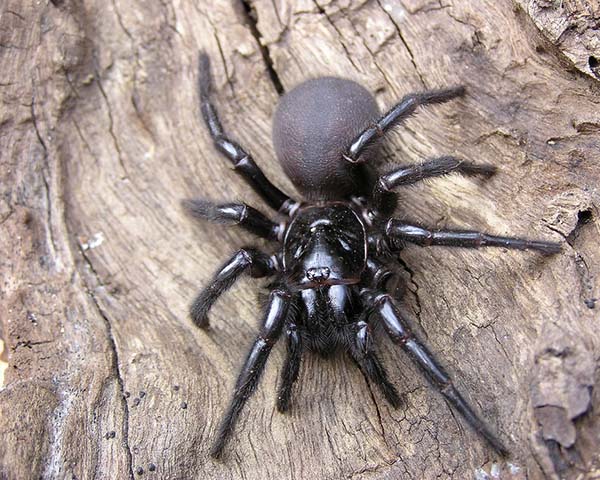
Sydney Funnel Web Spider
Sydney Funnel Web Spider
The most deadly spider in Australia
The Sydney funnel-web spider is medium to large in size, with their body length ranging from 1cm to 5cm, their legs can reach 7cm. Males and Females are dark and Shiny. They’re mostly black with a slight burgundy, blue or brown tinge. Males are smaller in body size but have longer legs than females. Funnel webs have 2 long spinnerets (silk spinning organs) after their last pair of legs.
The Sydney funnel-web spider prefers to make its home in shady areas that are sheltered which are always cool and humid. Their natural habitat are rainforests and sclerophyll forests, though they can be found in local gardens. They line their burrow with silk which is normally situated beneath objects like rocks or logs, and sometimes reach up to 600mm in length.
These Spider’s prey are mostly insects but they sometimes capture larger victims like frogs and lizards. Most burrows have two entrances which are lined with silk, silk lines are attached to nearby rocks, roots, etc. These threads can also act as trip-lines, which alert the spider when prey is nearby.
Funnel-web bites are the world’s most deadliest spider, their venom is highly toxic for humans. When they bite they generally strike multiple times because of how defensive they are. You will notice if you have been bitten because of their clear fang marks. their venom has the ability to kill a human in 15 minutes which is why if you suspect you’ve been bitten by one you need to get immediate help. If you notice funnel-webs in or around your home it is extremely important to get them under control as soon as possible.
Female Funnel-web spiders can live up to 20 years. males usually die 6-8months after reaching sexual maturity around 4 years. The female produces an egg-sack with about a hundred eggs and stores them in her burrow until they hatch. Females spend almost their whole lives in their burrows waiting for suitors and breeding. These spiders are a huge risk to humans, so if you find them you need to control them before their population grows.

Red Back Spider
Red Back Spider
Common and highly venomous
The redback spider is a highly venomous spider, believed to originate in Australia. The female is black with a red or orange marking, sometimes with thin white lines on its back. They can grow upto 15mm long. Males are substantially smaller and only grow up to 5mm long. Males are brown with a white marking. Only the female redbacks bite is dangerous.
Redbacks like to hang around human-inhabited areas, they are commonly found in dark, dry areas such as in floorboards, shelves, under flowerpots, under stairs. Outside suburban areas they are found under rocks and logs. Their silk is sticky so it’s easier to catch their prey. Redbacks are mainly nocturnal, she hides during the day and spins her web during the night.
Redbacks mainly prey on insects, though they are known to catch larger animals too that gets stuck in their web, including lizards, woodlouse and rarely snakes. Growing spiderlings need prey that are small enough to consume like fruit flies. Food scraps and lighting attracts insects to areas where humans are which is what brings the Redbacks, so make sure not to leave scraps lying around.
Redback females are the only ones who bite, if you are bitten you need to go seek medical help straight away because there is an anti-venom. Though it is rare to die from a redback bite it is possible especially if you get an allergic reaction. If a child, elderly, asthmatic or diabetic gets bitten they are at the highest risk of danger. The symptoms of a redback bite include, sweating, muscular weakness, loss of coordination, nausea and vomiting.
Female Redbacks take about 2-3 months to mature and can lay 3-8 egg sacks between September in May (the hotter months). Each sack contains about 300 eggs, but not all survive because they are eaten by their siblings. If you notice Redbacks it’s important to get them under control to ensure the safety of your family.
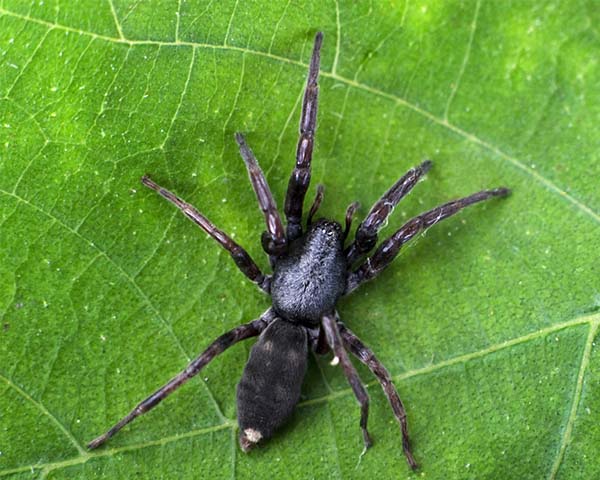
White Tail Spider
White Tail Spider
Common with a painful bite
White-tail spiders are one of the most dangerous spiders in Australia, they are native. The Females are larger and grow up to 18mm long while males sit at about 12mm in body length. Their legs span approximately 28mm. White-Tail spiders have glossy legs, bodies are dark reddish to grey, their abdomen have light white spots (less noticeable in adults) with a white spot at the tip.
White-tails live in dark areas such as gardens, inside houses, under barks or rocks, sometimes found in clothes, towels and shoes. These spiders don’t build webs. These spiders are mostly active at night to search for prey and are generally active in summer and found in southern region of Australia. They do have spinnerets (silk spinning organs) to make silk though they don’t live in webs.
They are slow moving spiders which mean they can wander long distances looking for prey. White tail hunt at night and are active hunters, their main prey are other spiders such as, Daddy long legs, Redbacks, and Black house spiders (their favourite food item).
If a White-tail bites it normally targets your arms or legs, and can be painful. Their bite looks similar to an insect bite that is a itchy red bump except it will most likely blister. The bite may cause various symptoms such as, stinging or burning, swelling around the bite, discoloured skin, nausea, vomiting. If the burning continues and it is blistering you may need the anti-venom, go seek medical attention.
Female White-tail Spiders lays around 80-100 pink eggs in a silk sack, she creates this right after mating. Once the female White-tailed Spider lays her eggs, she will than cover them with more silk. She guards the eggs until they are hatched. If you find White-tail spiders in or around your home it is important to get them under control to ensure the safety of your family.
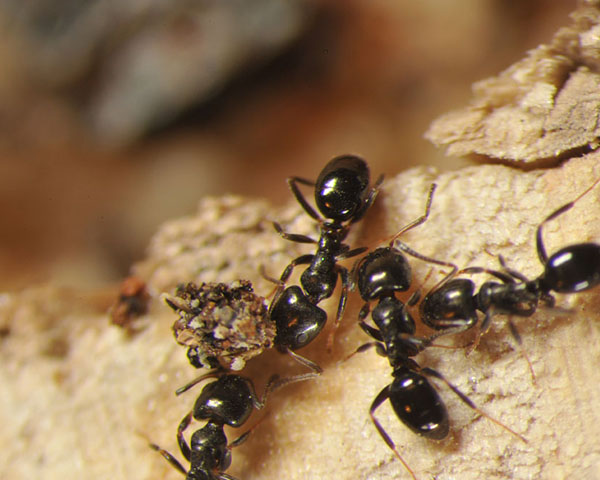
White Footed House Ant
White Footed House Ant
Nuisance species
The White-footed house ant have 6 legs and are about 2.5mm-3mm long and are a cloudy black colour with yellowish-white feet. These ants have 5 abdominal sections and have a couple hairs that stand up on their body.
The white-footed ant nests above ground level, Their nests are usually found in trees, tree holes, bushes, and palm fronds, under leafs on trees, in loose mulch, under debris, leaf litter (on the ground and in gutters) etc. These nests are generally found outside instead of inside but it is possible. Preferred nest sites provide closeness to moisture and food sources as well as protection from predators and weather extremes.
White-footed ants prefer sweet foods they will also eat dead insects and other proteins. They are generally are found foraging along branches, trunks of trees and shrubs that have nectars. White-footed ants will readily invade homes in search of sweet liquids and water. Unlike most ants, foraging white-footed ants do not share their food with other ants. Instead, many of their workers in the colony lay eggs which are called trophic eggs, which is the food source for the larvae and the non-foraging adults.
These ants don’t bite or have a stinger, they can’t harm humans physically and don’t cause any structural damage but they do become nuisances. The white-footed ant is an extremely difficult pest to control due to the large size of its colonies.
Like many other ants, white-footed ant colonies produce winged males and females, at certain times of the year they leave their nest to start new colonies. This is called swarming. Winged males mate once before they die. Winged females die about 400 days after starting a colony. The queen ant is then replaced by a female without wings that mates with a male without who can mate multiple times.
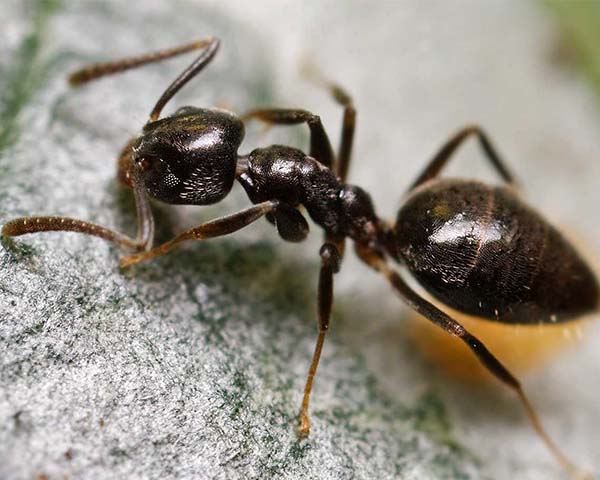
Odorous Ant
Odorous Ant
Rapid reproduction, can be a massive nuisance
Odorous ants are small and are about 2.4mm to 3.3mm in length. They are dark brown or black and have one node on their petiole (waist) which is hidden by their abdomen. Odorous house ants have an unevenly shaped ribcage when viewed from the side. The most noticeable characteristic of these ants is the smell of rotten coconut that they give off when their bodies are crushed which is why they were given the name they’ve got.
These ants nest indoor and outdoors. When they are inside they nest in warm places such as, wall crevices, under carpets, near heaters, water pipes and beneath floors. Outside these ants nest pretty much found anywhere but commonly under rocks and soil. Odorous ants have trails up to 50 feet long that connect to sub colonies or food sources.
Odorous Foragers collect food that is near the nesting area and bring it back to the colony to share it with the other ants, they prefer to feed on honeydew from aphids and mealybugs. Honeydew is not around as much in autumn, they can move indoors for food. When they are Indoors, they forage meats, sweet foods, dairy, pastries,vegetables and fruit.
Interaction between these ants and humans don’t usually occur, but if there are options to nest inside they may venture there. The Odorous don’t sting, don’t usually bite unless their nest is disturbed and cause any proper structural damage.
Queen Odorous ants can lay up to 30 eggs a day, but averagely lay one or two eggs a day. After they lay these eggs in a new nest the worker ants care for the larvae providing food etc. until they emerge as adults in roughly 38 days. Colonies can range from having 100-1000 ants in their colony. These ants can become pests once there is too many of them and need to be dealt with if you discover an infestation.

Coastal Brown Ant
Coastal Brown Ant
Can cause structural damage if left untreated
The Coastal Brown ant is an introduced species originating from Africa. These Invasive ants are also referred to as the “Big headed ant” as their heads are extremely large against their small bodies. The Coastal brown ant are Light ginger in colour with darker heads. They have 6 legs and range from 2mm-4.5mm long.
The Coastal brown ant colonies generally nest underground in soil along pathways, gardens, lawns, against walls, and under houses. They will nest above ground if there is soil available, and are active most of year. These ants expand their colonies by following the edges of a lawn or pathway where soil is normally deposited. They’re considered a nuisance species as they’re often found throughout the house in bedrooms, bathrooms and kitchens.
Their food preference is fatty foods but will consume other varieties such as seeds, meats, fruit, honeydew from aphids and excretions from Larvae. They also feed upon other insects and will dissect them and carry the pieces back to their nest. The major worker (The ones with the large heads) are the ones that do the dissecting.
The Coastal brown ant don’t usually bite unless their nest is disturbed and even then their bite doesn’t usually cause any pain. These insects have tendencies to form “super colonies” which are many interconnecting nests, a mass infestation. In instances like these the removal of small amounts of soil from concrete and brick paving eventually causing subsiding and cracking.
There are 3 different castes of adults, Worker ants are wingless and live for about 1 year. Winged males, their function is to mate with females. Females are winged and live for many years. Once fertilised queens shed their wings and find a suitable spot for a new colony. She will lay upto 290 eggs per month. The eggs hatch after 2-4 weeks. Larvae are first which are fed by the workers, they evolve to pupate a month later, they become adult workers ten to twenty days after that. These ants are a very successful invasive species, as soon as they are noticed they need to be dealt with.

Carpenter Ant
Carpenter Ant
Very painful bite, aggressive ant
The Carpenter ant is a larger species of ant, Their size ranges from 3mm-12mm. However size isn’t a reliable way to identify a Carpenter ants, though they can be identified by their uneven profile of their thoras. They are most commonly black but can have yellowish and red colouration.
Carpenter ants create nests in both outdoor and indoor areas such as rotting trees, tree stumps, logs buried or on top of the ground. They also nest in decaying wood in buildings. They prefer areas that are moist, decaying or hollow wood. They remove the wood to create galleries and tunnels to move around in and nest.
Carpenter ants feed on protein and sugar, though when they are outside they feed on living and dead insects. They are also very attracted to aphid honeydew also known as “plant lice”. Common items they like to feed on include, meats, pet food, syrups, honey, sugar, jelly etc. These ants don’t eat wood.
These ants do bite if their nest is disturbed, due to their large size their bite can be painful and possibly break the skin. Carpenter ants also spray a defensive chemical of formic acid which they can also spray into the bite which will increase the pain, they use this ability to fight other insects when threatened. They’re capable of damaging any wood, Carpenter ant infestation can become severe when left untreated so it is extremely important to contact help when you suspect you have infestation.
Carpenter ants can have colonies with over 3,000 of these ants. Female ants are the ones to search for a new site to build a colony. The queen usually seeks a small crack in the chosen wooden structure. She closes the chamber and remains inside until her first batch of eggs become adults. It takes 6-12 weeks from egg to adult, during this time the queen reserves and wing muscles and fat for nourishment. A carpenter queen can live up to 25 years and lay thousands of fertilised eggs during her lifespan. As the colony grows, they expand inside the wood, which causes even more damage.
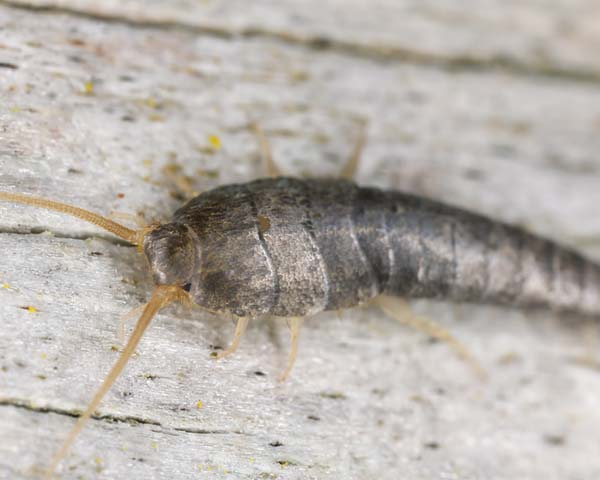
Silver Fish
Silverfish
Commonly found in pantries and food containers
Silverfish are nocturnal insects typically 13mm-25mm long. Their abdomen tapers at the end which gives them a fish-like appearance. New Silverfish are whitish but develop a grey and metallic shine as they mature. They have a long fairly flat body that tapers at the end, are wingless, and wriggle as they move quickly, but they can be very annoying and destructive household pests.
Silverfish enter houses on their own or in something that is brought inside like a box that’s been outside for a while. They are usually found in humid, damp areas (but capable to thrive in any climate). Places like attics, basements, laundry rooms, kitchens, and bathrooms. If a building is new and still has moisture in the structure they can found in large numbers. During the day they hide in crevices and cracks, at night they become active and forage for food.
Silverfish aren’t picky eaters, they will eat nearly anything. They feed on paper, wallpaper, photographs, books (any type of paper), starch in clothes, various fabrics, glue, and any foods with carbohydrates that they can find. These include oats and other cereals, breads, and sugar. They will also consume mould, dandruff, hair, dead insects and meat. They can survive months without food. Silverfish are a huge pest due to their construction and contamination of foods.
Female Silverfish can lay 2 or 3 groups of eggs every day, Each group contain clusters between 1 and 20 eggs. When these eggs are first laid they are soft and white, once a few hours have past the eggs go hard and turn yellow. Female silverfish generally hide their eggs really well in small cracks or crevices even in your clothes and food and are hard to spot. Their eggs hatch in about 19 to 32 days. Silverfish typically live for 2 to 8 years old. Silverfish are hard to spot and breed rapidly so it is extremely important to get these critters under control.

Bird Lice
Bird Lice
Can cause itching and swelling in humans
Bird lice are tiny, flat-bodied parasites. Bird lice can vary in length but usually less than 0.5mm long and are small enough to barely be visible. Bird lice are mainly translucent-yellowish until they feed on blood which makes them a reddish-brown colour. You can’t see their eggs without magnification because they are too small.
Bird lice are found on the skin, between the feathers and in bird nests, where they can form colonies of thousands. When their host dies or leaves the nest for good, this causes a mass departure as the lice go search for the humidity and blood they need to survive. They are very adaptable as parasites and have been known to infest the skin of many mammals (including humans), rats, mice, etc. If there are no birds nesting nearby you may get an infestation. Once the lice infest a household they will burrow into wood and fabrics. If your house has high humidity and lots of carpet or upholstery then you have the perfect environment for them to live in.
Bird Lice are nocturnal and feed at night, so if you do have an infestation you will feel it more at night time and it can be very discomforting. While they crawl around you can feel the sensation against your skin. They don’t bite particular part of the body, they aren’t fussy.
Bird lice can cause severe irritation including itching, swelling and raised reddish spots on the skin caused by mites injecting saliva when feeding, and can result in secondary infections from scratching. Bird lice aren’t associated with the transmission of any infectious disease. The bite is hard to diagnose and can be mistaken for the bites of other insects.
Bird lice infestations are very difficult to get rid of as they are hard to spot and they multiply extremely quickly because of their very short development cycle as it is only 1-2 weeks. Though Bird lice generally die after 3 weeks without a blood meal from a bird. Bird lice are extremely irritating and need to be dealt with if they’re suspected.
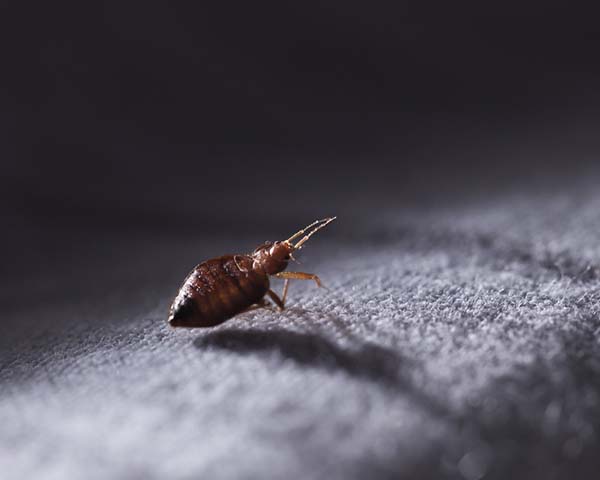
Bed Bugs
Bed Bugs
Suck your blood at night, cause itching and rashes
Bedbugs adults are 4-5mm long and 1.5-3mm wide, they have small, flat, brown-reddish, oval-shaped bodies. They can’t fly though they do have underdeveloped wings. They have very noticeable antennae and regularly release a foul odor. When Nymphs hatch they are nearly translucent and become more brown as they moult and mature.
Bedbugs are commonly found in mattresses, bed frames, drawers, under carpet, behind electrical outlets, and even under wallpaper. They will venture anywhere near your bed. They get into your house by hitching a ride on your clothes, shoes or luggage from other infected areas. Second hand items should always be checked before bringing them into your home.
Bedbugs are nocturnal and have a long beak and use it to pierce your skin and suck up your blood. They solely feed on blood from animals including humans. It takes them about 10 minutes to feed and become completely full. They feed every 3-5 days but if there’s enough of these bugs you will most likely get bitten every night until you get rid of them.
These crafty critters have a long beak and they use it to pierce your skin and suck up your blood. There’s a mild anaesthetic in their saliva, so you don’t feel them bite when you’re asleep. After their bite small red spots appear where they have fed. Bedbugs aren’t known to transmit any diseases, Though it is possible to get a allergic reaction to the bites, and if you suspect this happening you need to insure you or your pet gets help.
Female bedbugs lay between 1 and 5 eggs each day and can lay up to 500 eggs in a one lifetime. These eggs that look like rice grains are laid by itself or in a cluster and are placed within tight cracks or crevices. Within 2 weeks of the egg being laid it hatches and the freshly born nymph begins to feed immediately. these pests are extremely irritating, It’s very easy for an infestation to because of their rapid development cycle. It’s important to get them under control as soon as they are noticed.
Rats
Can cause structural damage and spread diseases
Rats range in size from 25cm-46cm (depends on the species), and weigh in at 110-340 grams. Generally the colour of wild rats are black, brown, grey or ginger. They’ve got rounded ears, black eyes, long whiskers and long tails. Males are usually larger than females.
Depending on the species some rats prefer arboreal habitats such as, trees, attics, in walls, and other elevated areas. Terrestrial rats prefer burrowing and areas on ground like, under floorboards, in walls, under leaves, tall grasses, etc.
Rats aren’t too picky when it comes to eating. They will feed on anything from fruit to carcasses, it depends on the breed, some prefer foods with high protein like meat or pet food and others prefer fruits or sweets. They’ll take advantage of many food sources such as garbage bins, your pet food bowls, open containers, Rats also eat their own feces, purely for the nutritional value.
Rats gnaw on anything, especially electrical wires which is a huge problem. This can cause electrical shortages which can sometimes lead to house fires “due to unknown causes”. This is extremely dangerous and if you suspect you have rats living in your attic (or anywhere in your home) have the problem taken care of as soon as possible.
Rats have large teeth and have painful bites when threatened, when they’re concerned they will bite to defend themselves. The saliva from some species are known to transmit (potentially) fatal diseases to humans, including the plague, viral hemorrhagic fever, weils disease, and Q fever. Humans bitten by rodents can also be affected by tetanus infections. If you’re bitten seek medical help right away.
A female rat can mate as many as 500 times with various males during a six-hour period which is something she experiences about 15 times per year. A pair of rats can produce as many as 2,000 offspring in a year. The average lifespan of rats is about 2.5 to 3.5 years. Rats matures sexually at 3-4 months old. They Rapidly grow in number so if you notice rats in your home it’s important to get them under control.
Mice
Can cause structural damage and spread diseases
Mice are small rodents with a tail as long as their bodies, they’ve got small rounded ears, pointed snouts. They grow up to 20 cm from their nose to the tip of the tail and weigh in at about 12-30 grams. Mice have short hair covering their bodies, which are black, grey and different browns.
Mice are more active at night but can be seen during the day roaming your house. They’re often spotted scurrying along walls or running from a disturbed hiding place. They’re very adaptive and can live in many areas and are active year around searching for warm areas to nest. Mice prefer to build nests that provide a dark protective environment such as, insulation, in walls, under floors, in attics, behind cupboards, under furniture, etc.
Mice are omnivorous, which means they eat both plants and meat. They like to eat fruits, seeds and grains though the common house mouse will eat just about anything it can find. If food sources are limited they will even eat each other. They have avid appetites, they eat around 20 times a day, so they build their nests near accessible food.
When your home is infested with mice, they will gnaw on almost anything. Humans will often find chewed up books, papers, insulation and wires – which is extremely dangerous and can cause electrical shortages. Mice don’t eat these items, they’re used to build nests.
Similar to rats, mice also transmit rodent-borne diseases such as hantavirus, weils disease, salmonellosis. These can be transmitted by a bite or scratch, contaminated air with rodent feces and urine, ingestion by contaminated food or drink, or direct contact with their bodily fluids. Diseases like these can be quite dangerous if untreated, if suspected seek medical help straight away.
A female mouse produces 5-10 litters annually and each litter consists of about 6 baby mice who are able to reproduce within 30 days of age. Because of their rapid growth and able to reproduce early in their lifetime, it is very important get the infestation under control.

Feral Birds
Feral Birds
Can cause structural damage and spread diseases
The main feral birds that are pests in Australia are Indian myna birds, and feral pigeons. Pigeons are medium-large birds with small heads and short legs. They have a blue-grey heads with shiny greenish, yellow, and reddish-purple marking and splotches along their bodies, and grey bill. The Indian myna are medium sized, they have a brown body with a black head, they’ve got a yellow bill, legs, around the eyes, and a few white patches on their wings.
Feral pigeons are commonly found almost entirely in areas of human habitation. They don’t migrate, they stay near where they were born (which may be your home). Pigeons like to nest along building ledges, bridge supports, window sills etc. Indian mynas are also associated in areas where humans are. These mynas like to gather in large areas and nest in places like roof voids, large trees, etc. The nests they build are large and untidy and are a fire hazard especially in houses.
Feral birds seek out readily available food sources, like garbage, pet food, insects, seeds, fruits, Make sure you move your pet bowls inside and don’t encourage these birds to eat human foods because they will be back for more.
Feral birds attract ticks, cockroaches and rats. They damage buildings, monuments and nature (pigeons have acid in their feces). Mynas are aggressive birds and aren’t afraid of humans. The feces from these types of birds cause hygiene concerns, and increase the risk of disease and parasite transmission between other feral birds, domestic birds, your pets and even humans.
Most feral birds mate for life, during the breeding season there is usually competition for nesting sites. These birds breed anytime of the year, but their favourite are spring and summer. They usually mate for life, pigeons will lay 1-3 eggs about 4 times a year. Mynas will lay 4-6 eggs at a time, the incubation period for these birds is roughly about 18 days, and live for about 4 years in the wild. If feral birds are noticed they need to be controlled before the cause to much destruction.
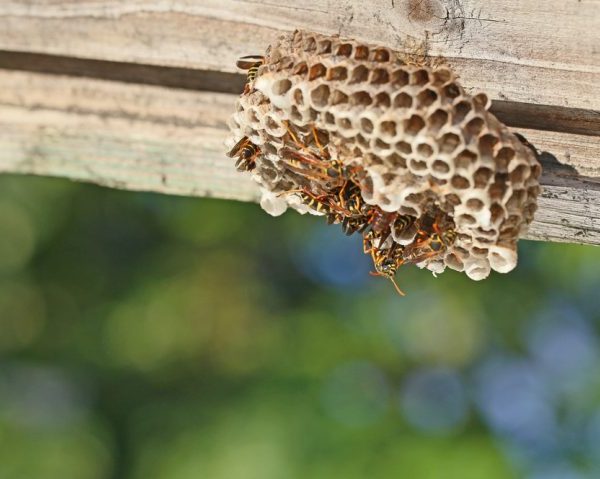
Wasps
Wasps
Painful sting, very aggressive
Wasps generally have a pair of wings and a pinched waist, but the varies tremendously depending on the species (there are over 12,000 species of wasps) They range in colours from orange, yellow, black, brown, green, etc and vary in size from microscopic to several centimeters long.
There are 2 categories of wasps which are social or solitary. Social wasps live in colonies, which are made up of thousands. These wasps build their nests above ground in hidden locations such as trees, bushes, attics, etc. Solitary wasps live alone and don’t belong to a colony. These wasps build their nests underground under fallen logs, rocks, and concrete.
Social wasps are omnivorous, feeding on fallen fruit, nectar, and already dead insects. They commonly return to locations they have previously found prey. Adult solitary wasps mainly feed on nectar, though most of their time is taken up by foraging for food for their carnivorous young, mostly insects and spiders.
Wasps can be very aggressive insects, their stingers do not break off (unlike bees) because of this they can sting repeatedly. Their stinger contains a venom which causes, itchy skin, can be very painful, and swelling for 24 hours. Wasps that nest inside may damage your ceiling and walls, this can be especially dangerous if you experience an allergic reaction to their sting which can be common. It’s important to take precautions when they are near to avoid injury.
Most species of a social wasp female and male mates once a year, after mating the female hibernates in a confined space until winter is over, while the male dies. In spring the fertilised female starts her colony by laying her eggs in pods. Adult workers appear 10 days after to care for the eggs. Solitary females are always fertile, They commonly they their eggs near a spider or insect they have paralysed. Mothers do that so when they develop into larvae they can feed. The majority of wasps life upto 1 year.

